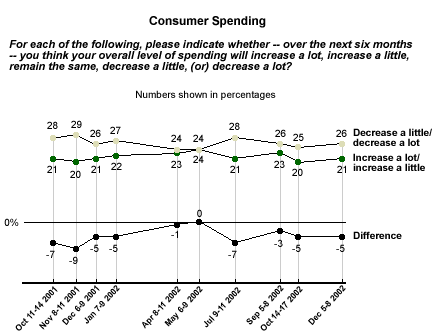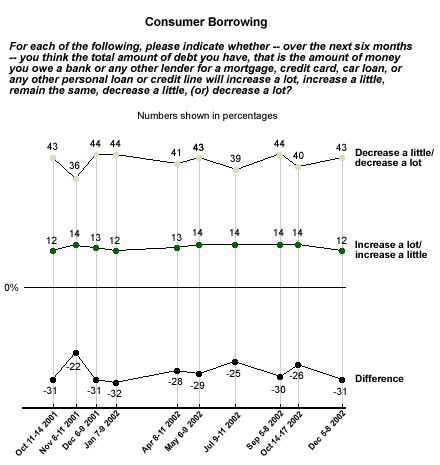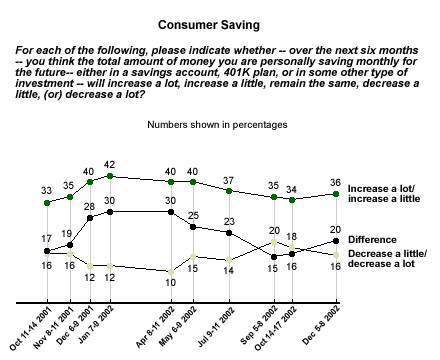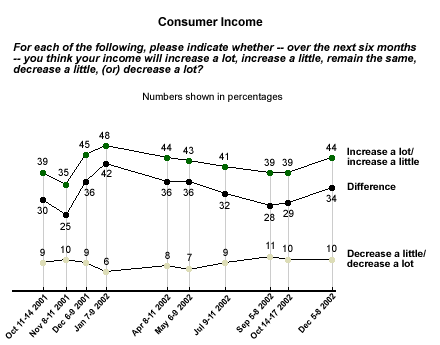As 2002 comes to a close, Gallup Poll economic data* suggest that U.S. consumers intend to spend and borrow less while saving more during the next six months. While consumer confidence -- like investor optimism -- has improved somewhat over the past few months, it remains at low levels. In fact, more Americans now say current economic conditions are "poor" (28%) as say they are "good" or "excellent" (24%). Further, half of American consumers (50%) tell Gallup that economic conditions as a whole are "getting worse," while only 35% say economic conditions are "getting better."
More Consumers Plan to Spend Less
In December 2002**, more consumers say they plan to decrease their level of spending over the next six months (26%) than say they plan to increase it (21%) -- a negative differential of five percentage points (21% increase minus 26% decrease). In December 2001, this differential was exactly the same, as were the percentages. This differential shrank during the first half of 2002 and disappeared in May, with 24% of consumers saying they planned to spend more and an equal percentage saying they planned to spend less. During the second half of 2002, this improved outlook for consumer spending -- like consumer and investor confidence -- seems to have dissipated.

Consumers Also Plan to Borrow Less
More consumers also plan to borrow less than borrow more. In December, 43% of consumers said they plan to borrow less over the next six months, while only 12% said they plan to borrow more. Once again, these percentages and the negative differential of 31 percentage points are virtually the same as they were in December 2001 (when 44% planned to decrease borrowing and 13% planned to increase borrowing). The fact that consumer borrowing intentions have not improved over the past year isn't good news for those hoping that consumers will continue to spend as much -- or even increase their spending levels -- early next year.

Consumers Plan to Save More
More than one in three consumers say they plan to save more over the next six months (36%), while only 16% say they plan to save less. This positive differential of 20 percentage points is down from December 2001, when the positive differential was 28 percentage points.

Still, More Consumers Expect Their Incomes to Increase
While more consumers are planning to spend and borrow less over the next six months, more also expect see their incomes increase over the same period. In the December 2002 poll, 44% of consumers said they expect their incomes to increase over the next six months, while only 10% say they expect their incomes to decrease. This 34-percentage point positive differential is down two points from the 36-percentage point differential in December 2001.

Key Points
In his Dec. 19 remarks before the Economic Club of New York, Fed Chairman Alan Greenspan repeated his earlier assessment that " . . . the U.S. economy has been working its way through a soft patch. And, the patch has certainly been soft." He went on to note that the current uncertainties surrounding the business outlook and the geopolitical situation present " . . . a rather formidable barrier to new investment."
In other words, the determining factor in the outlook for early 2003 will be the same as in 2002: consumer spending. Right now, consumers' attitudes toward spending are just where they were a year ago. This may not sound like bad news, given the high spending levels of the first quarter of 2002. Early next year, however, we are not likely to see another "rally effect," nor will we see the surge in auto sales due to new sales incentives. As a result, Chairman Greenspan's "soft patch" may get somewhat softer in early 2003.
*Results are based on telephone interviews with 1,007 national adults, aged 18 and older, conducted Dec. 19-22, 2002. For results based on the total sample of national adults, one can say with 95% confidence that the maximum margin of sampling error is ±3%.
**Results are based on telephone interviews with 1,001 national adults, aged 18 and older, conducted Dec. 5-8, 2002. For results based on the total sample of national adults, one can say with 95% confidence that the maximum margin of sampling error is ±3%.

